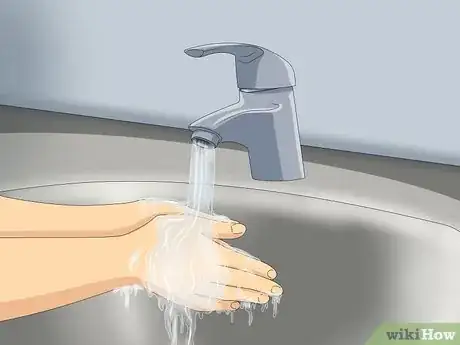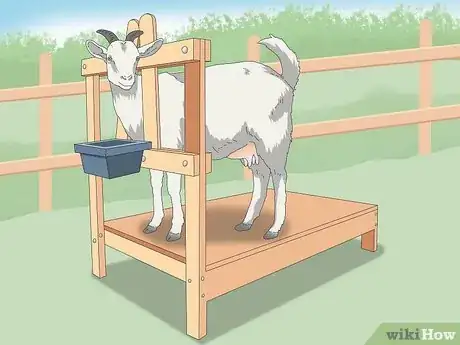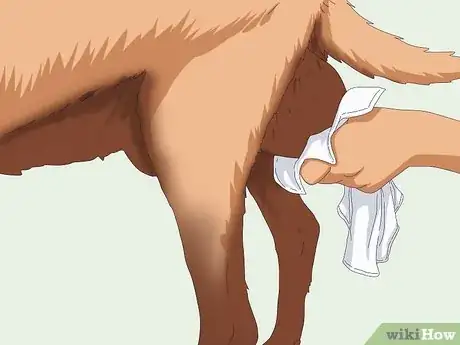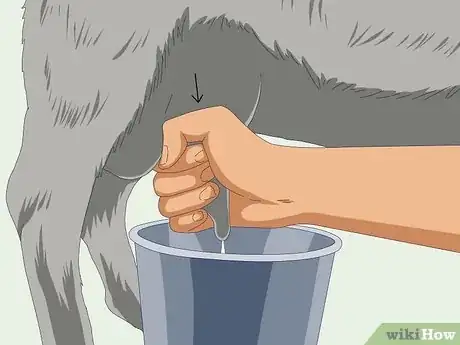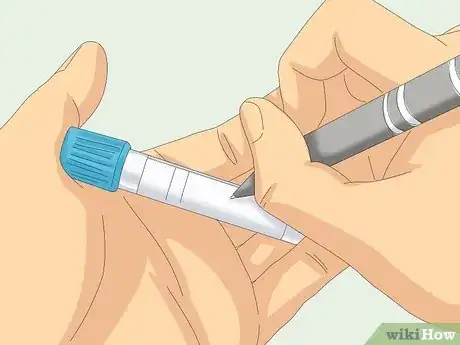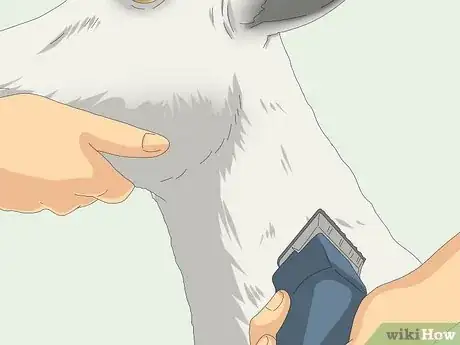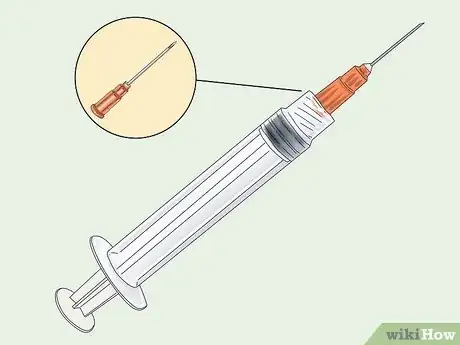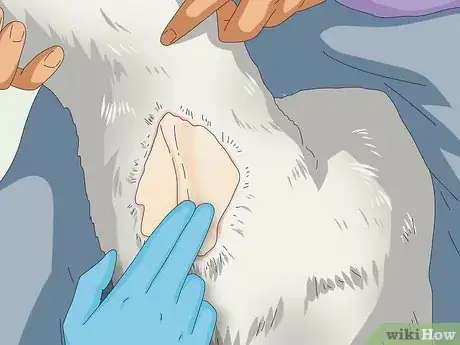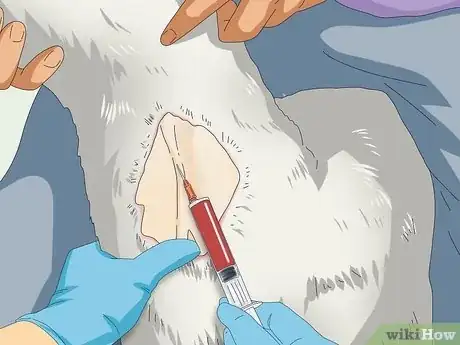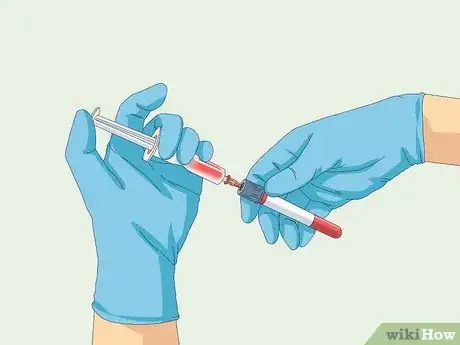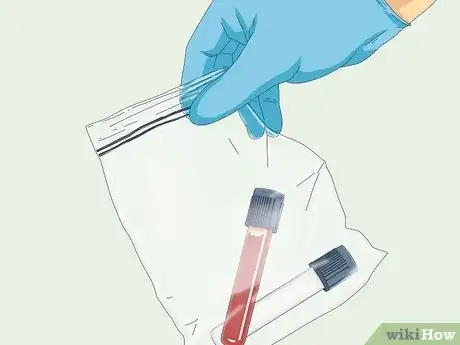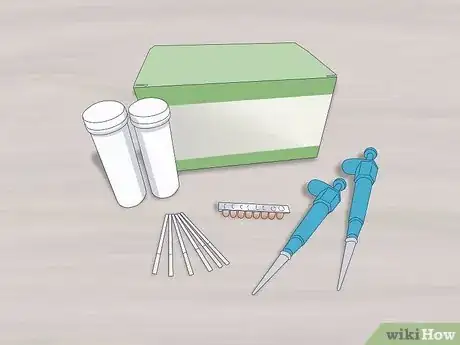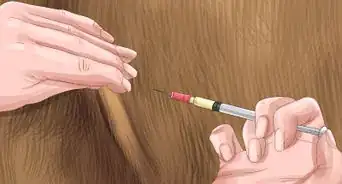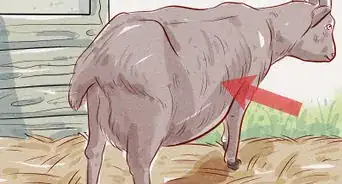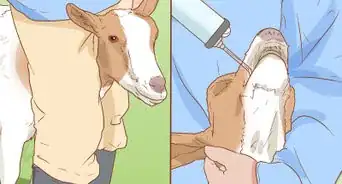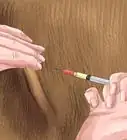This article was co-authored by Ryan Corrigan, LVT, VTS-EVN. Ryan Corrigan is a Licensed Veterinary Technician in California. She received her Bachelor of Science in Veterinary Technology from Purdue University in 2010. She is also a Member of the Academy of Equine Veterinary Nursing Technicians since 2011.
There are 18 references cited in this article, which can be found at the bottom of the page.
wikiHow marks an article as reader-approved once it receives enough positive feedback. This article received 19 testimonials and 100% of readers who voted found it helpful, earning it our reader-approved status.
This article has been viewed 129,363 times.
If you're breeding goats, you often can't tell a doe is pregnant simply by looking at her. Goats can look pregnant even with they're not due to the way they digest food. To know for sure if your goat is pregnant, you need to run a test. You can take samples of milk and blood yourself, and either send the samples away or run the test yourself at home. Alternatively, have your vet perform an ultrasound or x-ray.
Steps
Gathering a Milk Sample for a Pregnancy Test
-
1Wash your hands first. Thoroughly wash your hands with soap and warm water. Make sure to scrub for at least 20 seconds. You can introduce bacteria to the goat, which have open glands around the teat.[1]
- Plus, you don't want to introduce excess bacteria to the milk sample.
- Milk is easier to acquire than blood, but that only works for does who've given birth before and who are used regularly for milk.
-
2Place the goat on the milking stand. A milking stand elevates the goat, so you are able to reach the udder more easily. Help keep the goat quiet and happy by providing food while you milk it. A treat works even better.[2]
- You can also use the food to help lure the goat onto the stand. Treats you can use include fresh weeds or grass, alfalfa hay, or grain.[3]
Advertisement -
3Clean the goat's udder. To help keep the milk sample as bacteria-free as possible, wipe the goat's udder down with warm water and gentle soap. Wipe off the teats, as well, and rinse the whole udder with a bit of warm water.[4]
- You can use a dash of castille soap or a tiny bit of bleach in warm water. You can also use udder-cleaning wipes, which you can find at your local feed store.
-
4Milk the goat into a clean bowl. Grasp the teat at the top, pushing the milk down into the teat. Move the milk down by squeezing down the teat. Be gentle; you don't need to yank or pull. Use a clean bowl or bucket to catch the milk.[5]
- Dump the first few squirts out, as they are higher in bacteria.
-
5Collect a sample to send away using a clean dipper. Typically, the testing company will provide you with a dipper to scoop out milk from your bowl or bucket. Pour the milk into the provided tube, which should have a preservative in the bottom that will mix with the milk.
- Refrigerate the milk until you send it, and mail it as soon as possible after collection.
-
6Label the sample for mailing. Most labs require that you label each sample, and then load the tubes in a certain way so they're easy to identify. Read the information that came with your kit thoroughly, and fill out the requested forms and labels.
Drawing Blood for a Pregnancy Test
-
1Shave your goat for drawing blood. Distract your goat with food and place her in a head gate or another device that holds her head in place. Shave one side of her neck on the underside with standard clippers. You should be able to see the jugular vein now.[6]
- It's important to shave the goat so you can see her vein more easily. It's in about the same place that it is on humans.
-
2Place a 20-gauge needle in the top of a sterile syringe. Typically, you remove the caps on the syringe and needle except for the one on top of the needle. Twist the bottom of the needle into the syringe. It should click in place. Once you have it in place, take the cap off the needle end, too.[7]
-
3Have someone hold the goat in place for you to take blood. They should place one hand on the shoulder of the goat, pulling the goat in towards them. The other hand should go under the chin and around the top of the head, pulling the head in towards them and away from you.[8]
- You may need a person on the back end, too, to hold her in place.
-
4Put pressure on the base of the neck to pop the vein out. Use your hand to apply pressure to the base of the neck on the side you're on. You should see the jugular vein pop out above your hand.[9]
- You should be able to feel the goat's pulse in the vein.
- If you have trouble getting the vein to pop out, move the goat’s head away from the side you’re working on.
-
5Insert the needle into the vein and draw blood out. Push the needle in at an angle. Turn the needle the same direction as the vein but with the syringe closer to the skin on the same side as the base of the neck. In other words, don't stick it in at a perpendicular angle to the goat's skin.[10]
- Pull the plunger out, and you should see blood in the syringe. Draw the plunger back until you have enough blood for the test and then remove the needle from the goat's neck.
- If you don't see blood, you need to try again to hit the vein.
-
6Inject the blood into the sterile tube. You should have a sterile tube that came with your syringe kit. Plunge the needle into the rubber top. The syringe should automatically pull the blood into the tube because it's a vacuum. Pull the needle out when it's done.[11]
- Label the tube with the goat's name and the date, as well as any other information the company requires.
- If you're using a home test, you can simply use the syringe to push a few droplets of blood onto the testing stick.
Sending Samples and Confirming with Your Vet
-
1Send blood or milk away to a lab for a test. With these tests, you buy a kit online that they send to you. You fill the kit with a blood or milk sample, then send it back to the company. They test the sample to see if your goat is pregnant.[12]
- Check companies like BioTracking, Genex, Dairy One, and Rocky Mountain Instrumental Labs. Tests can run anywhere from $7-$20 USD.
- Typically, these tests measure progesterone or estrone sulfate. Estrone sulfate tends to be more accurate for a positive test, but only if you perform it 50 days after conception. Before then, it has about an 83% accuracy rate for positive and negative results.
- You can perform a progesterone test as early as 18-22 days after conception. However, it tends to be more accurate in its negatives than positives. It has a 75-86% accuracy in positive tests.
-
2Use a home blood or milk test for simplicity. With these tests, you order a testing kit online, and it's sent to you. Then, you take a blood or milk sample, and use the tester to check if your goat is pregnant.[13] Perform the test between the 18th and 22nd day after the likely conception. If you miss that window, do one on both the 23rd and 24th day for more accuracy.
- Typically, these work similar to a human home pregnancy test. You place several drops of milk or blood on the testing stick and wait for it to develop. The test takes about 5 minutes.
- Kits are $5-$10 USD apiece, and you usually buy them in bulk.
-
3Have your vet perform a blood test for you. A typical way to check for pregnancy is through a blood test. Your vet can do this test for you. You can either take the goat in or have the vet visit your home if that's an option.[14]
- These tests are usually inexpensive. They often run $20-$40 USD.
-
4Ask your vet to do an ultrasound for more accuracy early on. While blood tests and milk tests are somewhat accurate, the most accurate test is an ultrasound. Your vet can do an abdominal or rectal ultrasound to determine if your doe is pregnant.[15]
- Some vets do have portable ultrasound machines they can bring to your farm.
- A rectal ultrasound is more difficult to perform, but by using one, your vet can determine pregnancy as early as 20 days after conception. An abdominal ultrasound is accurate, but your vet usually won't be able to hear a heartbeat until 25 days after conception.
-
5Request an x-ray for accuracy in later pregnancy. At about 70 days, your vet can perform an x-ray on your goat. At that time, they can tell whether your goat is pregnant with 100% accuracy. However, this requires a trip to the vet.[16]
- At 75 days, the vet can usually tell how many kids the goat will have by counting the skulls.
Expert Q&A
-
QuestionHow long should I keep my doe separate so it doesn't mate after it gives birth?
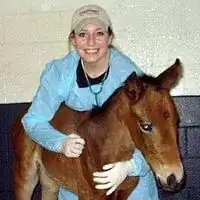 Ryan Corrigan, LVT, VTS-EVNRyan Corrigan is a Licensed Veterinary Technician in California. She received her Bachelor of Science in Veterinary Technology from Purdue University in 2010. She is also a Member of the Academy of Equine Veterinary Nursing Technicians since 2011.
Ryan Corrigan, LVT, VTS-EVNRyan Corrigan is a Licensed Veterinary Technician in California. She received her Bachelor of Science in Veterinary Technology from Purdue University in 2010. She is also a Member of the Academy of Equine Veterinary Nursing Technicians since 2011.
Licensed Veterinary Technician Keep the doe separated from others for at least 1 of its heat cycles. This will let the doe rest for a cycle.
Keep the doe separated from others for at least 1 of its heat cycles. This will let the doe rest for a cycle.
Warnings
- If you're unsure about whether your goat is pregnant or not, talk to your vet.⧼thumbs_response⧽
- Watch for signs of heat to confirm the doe isn't pregnant. If your doe goes back into heat, then she's not pregnant. Symptoms include her becoming very vocal, wagging her tail end, and having a dirty vaginal area because of discharge. She'll also urinate more and not be as hungry.[22]⧼thumbs_response⧽
References
- ↑ https://morningchores.com/how-to-milk-a-goat/
- ↑ https://farmingmybackyard.com/milking-a-goat/
- ↑ https://www.weedemandreap.com/how-to-milk-a-goat/
- ↑ https://www.flipflopbarnyard.com/how-to-hand-milk-a-cow-or-a-goat/
- ↑ https://www.flipflopbarnyard.com/how-to-hand-milk-a-cow-or-a-goat/
- ↑ https://www.youtube.com/watch?v=8aicYZSrV18&feature=youtu.be&t=77
- ↑ https://www.youtube.com/watch?v=8aicYZSrV18&feature=youtu.be&t=86
- ↑ https://www.youtube.com/watch?v=8aicYZSrV18&feature=youtu.be&t=201
- ↑ https://www.youtube.com/watch?v=8aicYZSrV18&feature=youtu.be&t=202
- ↑ https://www.youtube.com/watch?v=8aicYZSrV18&feature=youtu.be&t=221
- ↑ http://goatconnection.com/articles/publish/article_151.shtml
- ↑ http://www.5acresandadream.com/2014/10/determining-pregnancy-in-goats.html
- ↑ http://www.5acresandadream.com/2014/10/determining-pregnancy-in-goats.html
- ↑ http://www.5acresandadream.com/2014/10/determining-pregnancy-in-goats.html
- ↑ https://www.merckvetmanual.com/management-and-nutrition/management-of-reproduction-goats/pregnancy-determination-in-goats
- ↑ http://tiramarhomestead.com/2016/01/is-my-goat-pregnant-detecting-pregnancy-in-goats/
- ↑ http://tiramarhomestead.com/2016/01/is-my-goat-pregnant-detecting-pregnancy-in-goats/
- ↑ https://www.motherearthnews.com/homesteading-and-livestock/raising-sheep-goats/goat-pregnancy-and-labor-ze0z1412zdeh#axzz3Kwa9UsMm
- ↑ http://tiramarhomestead.com/2016/01/is-my-goat-pregnant-detecting-pregnancy-in-goats/
- ↑ https://www.motherearthnews.com/homesteading-and-livestock/raising-sheep-goats/goat-pregnancy-and-labor-ze0z1412zdeh#axzz3Kwa9UsMm
- ↑ https://www.motherearthnews.com/homesteading-and-livestock/raising-sheep-goats/goat-pregnancy-and-labor-ze0z1412zdeh#axzz3Kwa9UsMm
- ↑ https://content.ces.ncsu.edu/heat-detection-and-breeding-in-meat-goats
